![]()
![]()
![]()
Use LEFT and RIGHT arrow keys to navigate between flashcards;
Use UP and DOWN arrow keys to flip the card;
H to show hint;
A reads text to speech;
25 Cards in this Set
- Front
- Back
|
Reflexes: With the rooting reflex -- when does it occur, what stimulates it, what is the reflex response, and what is the relevance? |
![[Image]. The rooting reflex occurs during the first few months. Stroking lips causes baby's mouth & tongue to move to stimulus. Allows baby to locate feeding source.](https://images.cram.com/images/upload-flashcards/83/22/71/9832271_m.jpg)
[Image]. The rooting reflex occurs during the first few months. Stroking lips causes baby's mouth & tongue to move to stimulus. Allows baby to locate feeding source. |
|
|
Reflexes: With the suck-swallow reflex -- when does it occur, what stimulates it, what is the reflex response, and what is the relevance? |
The suck-swallow reflex occurs during the first 2 to 5 months when an object, like a finger or nipple, is placed inside the infant's mouth the baby begins a strong rhythmic sucking. Obviously, this allows ingestion of nourishment. |
|
|
Reflexes: With the Asymmetrical Tonic Neck Reflex -- when does it occur, what stimulates it, what is the reflex response, and what is the relevance? |
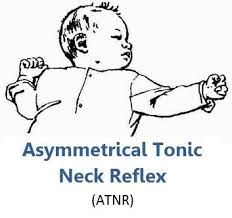
[See image.] The Tonic neck Reflex, occurs in the 1st 4 to 6 weeks. When you rotate head and hold for 5 seconds, like the "fencing" posture the forward UE extends while the back one flexes. This promotes visual hand regard. |
|
|
Reflexes: With the Palmer Grasp reflex -- when does it occur, what's the stimulus and the reflex response, and what is the relevance? |
The palmer grasp occurs during the first 4 to 6 months when you place your finger in the infant's hand, she responds by flexing and a reflexive grasping. This increase tactile input on the palm of the hand. (Whatever) |
|
|
What does the Landau Reaction Reflex look like? |
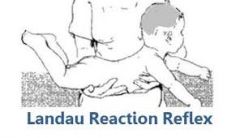
See the Image.
|
|
|
What does the Backward Parachute Reflex look like and what is its other name? |

See image. The other name for Backward Parachute Reflex is Protective Extension Reaction Backward. |
|
|
What does the Forward Parachute Reflex look like and what is its other name? |
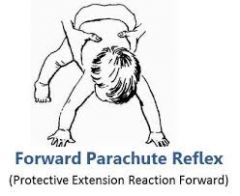
See image.
|
|
|
What does the Sideward Parachute Reflex look like and what is its other name? |
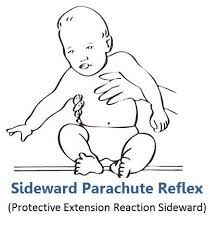
See image.
The other name for the Sideward Parachute Reflex is the Protective Extension Reaction Sideward. |
|
|
Motor development typically develops (or returns) in what pattern? |
Motor development typically develops (or returns) in 3 patterns, as follows:
1. From a proximal to distal direction. 2. From gross to fine movement. 3. From stability to controlled mobility. |
|
|
To memorize developmental milestones, what are the ages to look at? |
The ages to look at when memorizing developmental milestones are 1, 6, and 9 months, and 1, 2, 3, and 4 years. |
|
|
Name the motor, language, and social milestones of a 1 month old. (Clue about fine motor skills -- they ain't got none!) |

The four milestones of a one month old are: 1. raises head 2. tracks with eyes 3. coos 4. recognizes parents |
|
|
For 6 month milestones, what is the image that helps you remember? Then name the gross motor, fine motor, language, and social milestones of a 6 month old. |
The image to remember 6 month milestones is imagining that the infant is actually a number 6. The loop is his butt sitting on the ground. The milestones of a 6 month old follow: 1. Sits up, 2. Raking grasp, 3. Babbles, 4. Stranger anxiety. |
|
|
For 9 month milestones, what is the image that helps you remember? Then name the gross motor, fine motor, and social milestones of a 9 month old. |
The memory image is the baby actually being a number 9. The loop is the head going in the left direction. Little arms come off the stem reaching to the left to grab hold of the cart he must hold in order to do assisted walking. Milestones include: 1. Walking with assistance, 2. 3 finger grasp, 3. waving bye-bye and playing pat-a-cake. |
|
|
For 1 year milestones, what is the image that helps you remember? Then name the gross motor, fine motor, language, and social milestones of a 1 year old. |
The image to help remember is a baby holding his mother's 500 pound pocket book in the shape of a numeral 1 with a 2 finger pincer grasp, imitating her walk, and saying "mama, dada"). Milestones for a 1 year old are: 1. Walk, 2. 2 finger pincer grasp, 3. Says mama and dada, 4. Imitates parents. |
|
|
For 2 year milestones, what is the memory image and how does yo ass remember the answers? And what ah doze answers? |
Two year milestones almost all have a 2 in them. The memory image is the number 2 climbing stairs, saying "fock you, fock you, fock you". Two year milestones are: 1. 2 steps (in other words, climbs stairs), 2. 2 word phrases, 3. Follows 2 step commands, 4. Can stack a bunch of blocks (allegedly 6, to quote the exact generalization). |
|
|
For 3 year milestones, what is the memory image that contains all the answers? And what ah doze answers? |
The memory image is: the numeral 3 riding a tricycle in a circle while brushing her teeth and repeatedly saying "fock you bee-otch, fock you bee-otch, fock you bee-otch." The 3 year milestones are: 1. Tricycle riding, 2. Three word sentences, 3. Brushes teeth, 4. Can copy a circle, if not more. |
|
|
Three and four year old children develop with their ability to draw body parts. What's the [sort of useful] trick to remembering how many body parts they can draw? |
Kids age 3 and 4 should roughly be able to draw body parts approximately equal in number to their age. In other words, a three year old could draw an outline of a face with eyes and a mouth. Four year olds would add a nose to that drawing. |
|
|
For 4 year milestones, what is the memory image that contains all the answers? And what ah doze answers? |
To remember 4 year old milestones, picture a four year old child hopping with hundreds of other children on plus signs -- each child lifts a leg to hop and their legs form a large number 4. The four year milestones are: 1. Hopping, 2. Copying a plus sign (in other words, they can draw vertical and horizontal lines), 3. They play with others |
|
|
Regarding the progression of the pencil grasp, give the names of the different stages, describe them, and give the age ranges for reaching them. [Image] |
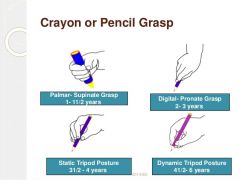
1. Cyllindrical or Palmar-Supinate Grasp, 1 to 1 1/2 years, 2. Digital or Digital-Pronate Grasp has no web. All fingers are on 1 side. Occurs 2 to 3 years, 3. Static Tripod or Modified Tripod is like painter holding brush for wide brush strokes, occurs 3 1/2 to 4 years, 4. Dynamic Tripod Posture, 4 1/2 to 6 years |
|
|
When does a child develop the fine pincer grasp? |
A child develops the fine pincer grasp at 12 months old. |
|
|
Cube grasp: What is the 1st stage of 4 that I'm memorizing called, what is the age range, and describe it. [See image.] |
![[See image.] The 1st stage I'm memorizing is called Primitive Squeeze Grasp. It occurs at 4 months and results in the hand pulling object back to squeeze precariously against the other hand or body with no thumb use.](https://images.cram.com/images/upload-flashcards/83/26/88/9832688_m.jpg)
[See image.] The 1st stage I'm memorizing is called Primitive Squeeze Grasp. It occurs at 4 months and results in the hand pulling object back to squeeze precariously against the other hand or body with no thumb use. |
|
|
Cube grasp: What is the 2nd stage of 4 that I'm memorizing called, what is the age range, and describe it. [See image.] |
![[See image.] The 2nd stage is called Palmar Grasp. It occurs at 5 months. The infant has fingers on the top surface of the object, pressing it into the center of the palm, with thumb supporting the side of the cube by adducting.](https://images.cram.com/images/upload-flashcards/83/27/48/9832748_m.jpg)
[See image.] The 2nd stage is called Palmar Grasp. It occurs at 5 months. The infant has fingers on the top surface of the object, pressing it into the center of the palm, with thumb supporting the side of the cube by adducting.
|
|
|
Cube grasp: What is the 3rd stage of 4 that I'm memorizing called, what is the age range, and describe it. [See image.] |
![[See image.] The 3rd stage is called Radial-Palmar Grasp. It occurs at 6 months. The fingers on the far side of the object press it against the OPPOSED thumb and radial side of the palm.](https://images.cram.com/images/upload-flashcards/83/28/17/9832817_m.jpg)
[See image.] The 3rd stage is called Radial-Palmar Grasp. It occurs at 6 months. The fingers on the far side of the object press it against the OPPOSED thumb and radial side of the palm. |
|
|
Cube grasp: What is the 4th stage of 4 that I'm memorizing called, what is the age range, and describe it. [See image.] |
![[See image.] The 4th stage is called Radial-Digital Grasp. It occurs at 8 months. The object is help with opposed thumb and fingertips, web space visible between, much like a gross pincer grasp.
The fine pincer grasp developing when? yeah ...](https://images.cram.com/images/upload-flashcards/83/28/32/9832832_m.jpg)
[See image.] The 4th stage is called Radial-Digital Grasp. It occurs at 8 months. The object is help with opposed thumb and fingertips, web space visible between, much like a gross pincer grasp. The fine pincer grasp developing when? yeah baby, at 12 months. |
|
|
Go through the 4 stages of cube grasping that you ass is mesmerizing, including names, age of occurrence, and name. Imitate the grasp with you hand now, as you answer this question. |
1. Primitive squeeze grasp, 2. Palmar grasp, 3. Radial-Palmar grasp, 4. Radial-digital grasp. |

